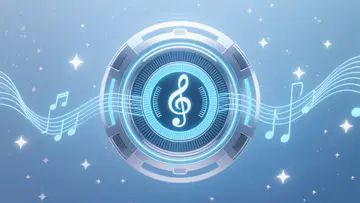Sync licensing has long been the backbone of music used in media—from blockbuster films to TikTok ads. But as AI-generated music becomes more mainstream, a new question arises: Can you license AI music for sync use?
Whether you're a filmmaker, game developer, brand manager, or indie creator, using AI-generated music requires careful attention to sync rights—especially if you're distributing to large platforms or monetizing your content.
In this article, we’ll walk you through everything you need to know about AI music sync licensing in 2025: legalities, best platforms, commercial use, and how sync licensing for AI music differs from traditional licensing.

Explore: Licensing AI Music in 2025: Legal Rights, Ownership & Commercial Use Explained
Synchronization licensing (or sync licensing) is the legal right to use music in timed relation with visual content—such as:
Films
TV shows
YouTube videos
Commercials
Video games
Mobile apps
In traditional music, sync licensing involves two rights:
Master rights – the actual recording (usually held by a label or producer)
Publishing rights – the underlying composition (usually held by a songwriter or publisher)
Using AI music complicates this model, because the music is either:
Created entirely by an algorithm
Co-created with a human through an AI platform
So how does licensing work?
Yes—but it depends on the platform used and the license terms offered.
Most AI music platforms offer royalty-free music for commercial use, but sync licensing typically requires:
A clear, commercial-use license
Proof of ownership or permission
Legal clarity on who owns the master and publishing rights
In short: you can’t assume AI music is safe to use in ads, shows, or games without a proper sync license.
Here’s how some leading AI music tools handle sync and commercial licensing:
Sync License Availability: ?
Usage Rights: Commercial use in ads, social media, games, and more
Ownership: You own a royalty-free license to use music
Limitations: You can’t resell music as your own for other libraries
Best for: Ad creatives, YouTube content, mobile games
Sync License Availability: ? (on paid plans)
Usage Rights: Music created via Boomy can be used in commercial content
Publishing: Boomy may retain some rights unless you opt out
Important Note: Boomy allows distribution to sync libraries like Epidemic Sound or Artlist via third parties.
Sync License Availability: ? (on Creator and Pro plans)
Commercial Rights: Yes, if on a paid tier
Ownership: Users own full rights to compositions they create
Best for: Film scores, game soundtracks, branded videos
Sync License Availability: ?
License Type: Royalty-free music engine with synced, loopable stems
Use Cases: TV, web ads, social media, app development
Sync License Availability: ?
Interface: Choose mood, genre, and scene—perfect for video sync
Rights: Royalty-free with clear sync licensing terms
Ideal for: Filmmakers and YouTubers looking for quick, custom music
Check whether you own the full rights to both the master and composition. Many AI platforms retain partial publishing control—even if you downloaded the track.
Download a sync license certificate or licensing agreement from the platform. This can help avoid YouTube copyright strikes or disputes during ad publishing.
If the AI platform is affiliated with a PRO (e.g., ASCAP, BMI), you may still need to report usage for broadcast or theatrical sync.
Most free AI music generators do not allow commercial sync licensing—or bury the restrictions in their terms of service. Always read the fine print.
Here are some examples of how AI music with sync licenses is being used today:
| Use Case | AI Tool | License Type |
|---|---|---|
| Instagram Ad Soundtrack | Soundful | Royalty-free sync |
| Indie Game Score | AIVA | Paid tier sync use |
| YouTube Vlog Background | Boomy | Commercial license |
| App Launch Video | Ecrett Music | Royalty-free, exportable |
| TikTok Campaign | Loudly | License included |
Yes. If your AI-generated track has a sync license, you can include it in content that is distributed on:
Netflix (indie licensing)
YouTube Ads
Spotify video content
Apple Music for Artists videos
Instagram & TikTok
But you must ensure full licensing rights—especially for commercial or broadcast use.
If you're creating videos or media content using AI music for clients or brands, you must:
Use a commercial-friendly AI tool
Download and archive license documents
Include licensing details in your delivery package
Avoid resale of AI music (unless allowed)
Clients may request full documentation for legal and tax reasons—especially in agency or corporate settings.
AI music sync licensing is 100% possible and legal—if done right. The key is using reputable platforms that offer clear commercial usage terms, ensuring you understand the limits of each license, and keeping documentation for every track you use.
As AI music continues to evolve, sync licensing will play a crucial role in how creators monetize and distribute their content. Stay proactive, read the terms, and protect your work (and your clients).
Is AI music safe to use in YouTube videos?
Yes, if you have a sync license. Platforms like Soundful and Boomy offer commercial usage rights.
Can I use AI music in a Netflix or Amazon Prime film?
Only if you have a full sync license and clear rights. Always verify with the AI platform.
Is AI music royalty-free?
Not always. Some platforms require attribution or have usage limits. Others offer full royalty-free licensing under paid plans.
Can I resell AI music for others to use?
No, unless the platform explicitly allows resale or sublicensing.
Do I need to credit the AI music platform?
Some require attribution under free licenses; most paid plans waive this.
Learn more about AI MUSIC